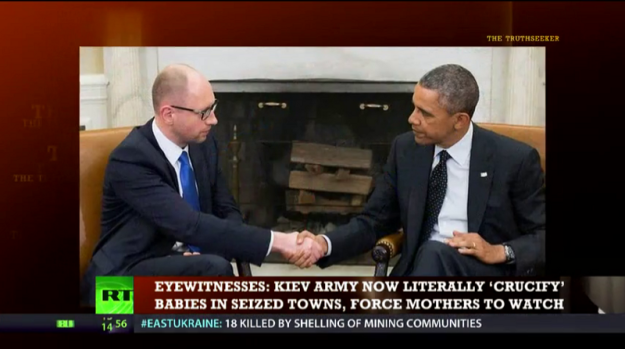By Jim Kovpak, for StopFake
Some readers are already aware of the Russian Foreign Ministry’s attempt to break into the fake news debunking business. It launched a few weeks prior to this writing and was a dismal failure. Rather than debunking actual fabricated news stories, the Foreign Ministry merely attached a Photoshop-made stamp to stories it deemed “fake,” including The New York Times’ story about the project itself. Now it seems the Russian state-run foreign language network RT wants to try its own hand at debunking what it deems fake news.
One wonders why a media outlet that is itself associated with disseminating fake news would be interested in calling more attention to the topic. In theory, the concept is laughably simple. Purveyors of fabricated stories and conspiracy theories the world over seem to have decided that their best defense lies in tossing the fake news label back at their critics. The idea seems to be if you’re engaged in debunking fake news, you couldn’t possibly also be producing it. Perhaps they think this approach is effective, but in practice it doesn’t work out too well, as we shall see with RT’s new fact checking site – Fakecheck.

So far the site features six allegedly fake stories. The first story is about a photo of a little girl that appeared on an Arabic-language Twitter account. The person who tweeted the photo claimed that the girl was running to escape Russian airstrikes in Aleppo. According to RT, the same Twitter account posts a lot of “anti-Russian and anti-Assad posts.” It also claims that the tweet and the photo were widely spread on social media. As it turns out, the photo actually comes from a music video by a Lebanese pop-star.
While the viral tweet is indeed distorted, is this actually fake news? Misattributed or altered photos are spread throughout social media all the time. In fact, such photos were being spread via chain emails long before social media even existed. In other words, this case really isn’t that much different from those photos of impossibly large housecats or the one that purports to depict an unlucky tourist on the observation deck of the WTC in New York just before the plane hits. It’s not as if major media organizations began spreading the photo and its fabricated story. At least it would seem RT didn’t find any that did.
It is mildly amusing to note that the pop song whose video provided the photo is supposedly called “Arab Spring,” and depicts acts of government violence against Arab protesters. RT would probably not like you to remember that the war in Syria began as part of the so-called “Arab Spring” uprisings, after Assad’s loyalist forces fired on peaceful demonstrators.
Moving on, our next story is at least an actual story. It involves a man who claimed that his mother died due to Donald Trump’s so-called “Muslim ban” immigration policy. In this case, it was at least an actual news story, as the man’s claim was initially reported by a local Fox affiliate. The story was also retweeted by Keith Olbermann , a well-known TV pundit. As it turns out, however, the man lied about his mother’s death being linked to the ban. How do we know? Well the same local Fox affiliate later talked to an imam who disputed the man’s story. In other words, the man made a claim, which the local news reported. Later more facts became available and they reported that the claim was unfounded. The Fox affiliate did not fabricate a story, and when it was disputed they reported the information as they ought to have done. This is not “fake news” and it certainly wasn’t debunked by RT.
The next story is about vloggers who documented the fall of Aleppo to regime forces last year. Are these videos fake? Are these people not in Aleppo? According to RT the problem is that they are “biased.” This is quite a shocking revelation- that people who were trapped in a besieged city suffering from repeated air and artillery strikes might harbor some bias against the regime that was carrying out such strikes.


The site then tries to claim that some of these vloggers had sympathy with Islamist groups. This is based on two pieces of “evidence.” One is a Facebook post from one of the bloggers, apparently mourning the death of Jaysh-al-Islam founder Zahran Alloush. Another one of the vloggers is shown posing with a militant fighter, who allegedly has a suicide belt. RT calls him a “suicide bomber,” but according to the picture’s caption, the fighters are wearing suicide belts to ensure that they are not taken alive by Assad’s forces should the government side break their truce. Given the well-established reputation of Assad’s security services, not wanting to be taken alive is understandable. Nothing so far demonstrates that these vloggers were fabricating anything about being in Aleppo. According to RT, the whole thing “looks like a PR campaign.” The irony is lost on them, apparently.
Moving on, RT asks why the “mainstream media” didn’t cover the thousands of refugees who took advantage of the ceasefire to flee into government controlled territory in Aleppo. Would The Guardian be considered mainstream media? Would Al Jazeera be considered mainstream? I must ask because after a two-second search in Google I found links to their stories about the evacuation, and RT seems to think so when they’re attacking them for featuring those aforementioned “biased” vloggers in Aleppo.
Once again, we don’t have a fake story, and RT doesn’t even dare call it fake. They claim the sources were “biased” and assert that they aren’t “innocent civilians” due to the questionable activities of two of them.
The next story is also not a fake story. Instead it is about the documentary The White Helmets, which is about the Syrian Civil Defense. According to RT, the group’s reputation is “dubious.” Dubious according to whom, you ask? Well to RT and other pro-Assad, pro-Kremlin media, of course. First the White Helmets are attacked for not working in government territory. I think it should be obvious why that argument is idiotic. Next it attacks them for only rescuing people while on duty. Apparently firefighters and policemen in the rest of the world work round the clock, every day of their lives until they retire. Next we see a video that purports to show two members of the White Helmets celebrating along what we’re told are armed members of the Al Nusra Front. Assuming that is what we’re seeing, I don’t see how that would reflect on the group as a whole. It’s not as if the men are actually fighting for Al Nusra.


Next we’re told that the group’s director was barred from entering the US due to suspected ties to extremist groups. This is utter nonsense. US officials initially refused to give an explanation as to why his visa was cancelled, but the explanation is most likely connected to President Trump’s so-called “Muslim ban,” in which Syria is included.
Next we have some interviews with civilians in government-controlled territory claiming that the White Helmets robbed and abused them. The interviewer is obviously RT. I’m terribly sorry but Russian state media has a well-established reputation for fabricated eyewitness claims, and these haven’t been substantiated elsewhere. You’re going to have to do better than that.
Next the site notes that the White Helmets participated in the so-called Mannequin Challenge, a viral video trend. Supposedly members of the group thought that participation would bring more awareness to their cause, but later they acknowledged it was in poor taste and apologized. The RT story notes that they apologized. If this is all some dastardly propaganda campaign, why would they ever apologize for anything? Russia’s state TV sure as hell never apologized for their infamous story about the “crucified boy of Slovyansk,” or any other fake story of theirs for that matter.
The next story comes from The Washington Post, and I’m going to use RT’s own wording here- “The Washington Post published a report on an alleged Russian operation that hacked into the US electricity grid.” See that word “alleged?” That’s kind of important. You’ll see why in a minute.
The story goes on to tell us that “hysteria followed” in the wake of WaPo’s piece. We are only shown headlines, which of course are specifically designed to be eye-grabbing. As it turns out, the power grid in Vermont was never actually hacked into by anyone.
According to RT, The Washington Post ran a “scaremongering headline,” which read “Russian Operation Hacked a Vermont Utility, Showing Risk to US Electrical Grid Security, Officials Say.” You know what’s more scaremongering in my opinion? The fact that someone at RT got paid to write this and never noticed the words “officials say” right there in the headline they are writing about. This site is supposed to debunk fake stories right? The story is only fake if the officials didn’t actually say that or if they never suspected the Russians. We’re not here to find out what RT thinks constitutes scaremongering.

So what did the officials say? When you go to the story they’re referring to, you immediately see a disclaimer explaining that an earlier version of the story contained incorrect information. RT claims that the site was “furiously editing” the story and that it took a while for the disclaimer to show up on the site. One could argue about whether they should have waited longer to publish the initial piece, but in general it seems they were just trying to accurately cover a rapidly developing story.

What is still correct is the discovery of certain code associated with Russian hackers on one of the Vermont utility’s computers. But a story published later, after the investigation had discovered more facts, explains what actually happened and why Russian hackers were initially suspected. In both cases WaPo was simply relaying what officials had told them, and they clearly pointed this out even in the headline. Once again we have a real news organization reporting a story and refining it as more facts become available. Their mistake is acknowledged both in the disclaimer in the original story and the follow-up piece. This story was not fabricated by The Washington Post, and thus it is not “fake news.”
So far it looks like RT’s attempt at joining the fake news debunking business is dead-on-arrival. They don’t even seem to understand the concept or even the definition of fake news. But that’s alright, because they can learn. All they need is a really easy story to start with. For example, they could try debunking this claim about a mysterious Spanish air-traffic controller who just happened to be working in the control tower at Kyiv’s Boryspil airport on the day that MH17 was shot down over Eastern Ukraine. The story of “Carlos” and his active tweet storm was debunked long ago, but I found a fake news site that still hosts a piece claiming that he could have been real. Surely RT can debunk this obviously fake story and many others which appear on the same site. If anything it will greatly improve Fakecheck, both in terms of content and quality! If you need any help learning how to properly identify and debunk a fake news story, visit StopFake.org.






